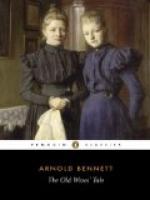The Baines’s shop, to make which three dwellings had at intervals been thrown into one, lay at the bottom of the Square. It formed about one-third of the south side of the Square, the remainder being made up of Critchlow’s (chemist), the clothier’s, and the Hanover Spirit Vaults. ("Vaults” was a favourite synonym of the public-house in the Square. Only two of the public-houses were crude public-houses: the rest were “vaults.”) It was a composite building of three storeys, in blackish-crimson brick, with a projecting shop-front and, above and behind that, two rows of little windows. On the sash of each window was a red cloth roll stuffed with sawdust, to prevent draughts; plain white blinds descended about six inches from the top of each window. There were no curtains to any of the windows save one; this was the window of the drawing-room, on the first floor at the corner of the Square and King Street. Another window, on the second storey, was peculiar, in that it had neither blind nor pad, and was very dirty; this was the window of an unused room that had a separate staircase to itself, the staircase being barred by a door always locked. Constance and Sophia had lived in continual expectation of the abnormal issuing from that mysterious room, which was next to their own. But they were disappointed. The room had no shameful secret except the incompetence of the architect who had made one house out of three; it was just an empty, unemployable room. The building had also a considerable frontage on King Street, where, behind the shop, was sheltered the parlour, with a large window and a door that led directly by two steps into the street. A strange peculiarity of the shop was that it bore no signboard. Once it had had a large signboard which a memorable gale had blown into the Square. Mr. Baines had decided not to replace it. He had always objected to what he called “puffing,” and for this reason would never hear of such a thing as a clearance sale. The hatred of “puffing” grew on him until he came to regard even a sign as “puffing.” Uninformed persons who wished to find Baines’s must ask and learn. For Mr. Baines, to have replaced the sign would have been to condone, yea, to participate in, the modern craze for unscrupulous self-advertisement. This abstention of Mr. Baines’s from indulgence in signboards was somehow accepted by the more thoughtful members of the community as evidence that the height of Mr. Baines’s principles was greater even than they had imagined.
Constance and Sophia were the daughters of this credit to human nature. He had no other children.




